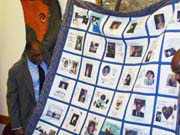Kathie Martin was in complete shock when police officers arrived at her house on a Halloween evening in 1994 to tell her that her son had committed suicide.
“I knew he was depressed, but I thought it was over school,” Martin said. “He suffered from perfectionism.”
Her son was a good student at Rutgers University and she could not fathom how his mental health had reached a point where suicide was an option. After all, he was due to graduate in December.
But since then, she has learned through various research, college courses, and volunteer work that the annual average of 30,000 suicides in the United States is a silent epidemic. Unlike diseases detected by blood tests, depression often goes unnoticed by friends, family, and physicians.
As a result, Martin has made it her mission to take the facts about suicide and bring them to the public whenever she can so that people can spot signs of severe depression in their friends, colleagues, and family members.
On Monday, Martin, a Jersey City resident, attended the council caucus meeting in honor of Mental Health Awareness Month. She brought her message along with a blanket that memorialized many victims of suicide by having their images on it. Each state has two blankets that people carry around to raise awareness for the cause, Martin said.
To reach the usual victims of suicide, Martin tries to approach the young and the elderly – the two age groups she said have the highest rate of suicides. Indeed, for the age group from 15 to 24, suicide was the third leading cause of death in 1999. And the highest suicide rates belong to white males over 85 years old.
Martin said many times, the deaths of elderly are not investigated as to whether it was suicide. As a result, she said that watching for signs of depression in the elderly is an important step to preventing potential suicides.
“It’s very hard with teens,” Martin said. “So many of them wear black clothes and black hair. It’s very difficult to know what are some of the definite signs. It starts with puberty and grows full-blown at the college age, which is why the suicide rate is so high in that age group.”
Some of those sure signs include overeating, oversleeping, and isolating oneself from others. Martin tells other teenagers that they are the best ones to read the signs because they are often closer to their peers than parents. She suggests that if students are worried about a peer, they should inform that person’s parents.
“The teen cure rate is the highest,” Martin said, “with medication and talk therapy because they’re catching it right away. And they do the best with depression and any of those things.”
Martin has talked to various health classes, including those at Dickinson High School. After one of these sessions, Martin learned that her advice wound up saving someone. “A kid saw the signs in a friend and told the parent,” Martin said.
Now, she is studying for her master’s degree in health science at New Jersey City University.
